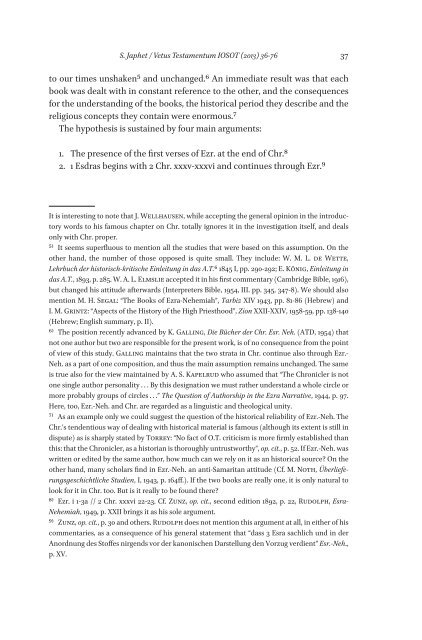Special Issue IOSOT 2013 - Books and Journals
Special Issue IOSOT 2013 - Books and Journals
Special Issue IOSOT 2013 - Books and Journals
You also want an ePaper? Increase the reach of your titles
YUMPU automatically turns print PDFs into web optimized ePapers that Google loves.
S. Japhet / Vetus Testamentum <strong>IOSOT</strong> (<strong>2013</strong>) 36-76 37<br />
to our times unshaken5 <strong>and</strong> unchanged.6 An immediate result was that each<br />
book was dealt with in constant reference to the other, <strong>and</strong> the consequences<br />
for the underst<strong>and</strong>ing of the books, the historical period they describe <strong>and</strong> the<br />
religious concepts they contain were enormous.7<br />
The hypothesis is sustained by four main arguments:<br />
1. The presence of the first verses of Ezr. at the end of Chr.8<br />
2. 1 Esdras begins with 2 Chr. xxxv-xxxvi <strong>and</strong> continues through Ezr.9<br />
It is interesting to note that J. Wellhausen, while accepting the general opinion in the introductory<br />
words to his famous chapter on Chr. totally ignores it in the investigation itself, <strong>and</strong> deals<br />
only with Chr. proper.<br />
5) It seems superfluous to mention all the studies that were based on this assumption. On the<br />
other h<strong>and</strong>, the number of those opposed is quite small. They include: W. M. L. de Wette,<br />
Lehrbuch der historisch-kritische Einleitung in das A.T.6 1845 I, pp. 290-292; E. König, Einleitung in<br />
das A.T., 1893, p. 285. W. A. L. Elmslie accepted it in his first commentary (Cambridge Bible, 1916),<br />
but changed his attitude afterwards (Interpreters Bible, 1954, III. pp. 345, 347-8). We should also<br />
mention M. H. Segal: “The <strong>Books</strong> of Ezra-Nehemiah”, Tarbiz XIV 1943, pp. 81-86 (Hebrew) <strong>and</strong><br />
I. M. Grintz: “Aspects of the History of the High Priesthood”, Zion XXII-XXIV, 1958-59, pp. 138-140<br />
(Hebrew; English summary, p. II).<br />
6) The position recently advanced by K. Galling, Die Bücher der Chr. Esr. Neh. (ATD, 1954) that<br />
not one author but two are responsible for the present work, is of no consequence from the point<br />
of view of this study. Galling maintains that the two strata in Chr. continue also through Ezr.-<br />
Neh. as a part of one composition, <strong>and</strong> thus the main assumption remains unchanged. The same<br />
is true also for the view maintained by A. S. Kapelrud who assumed that “The Chronicler is not<br />
one single author personality . . . By this designation we must rather underst<strong>and</strong> a whole circle or<br />
more probably groups of circles . . .” The Question of Authorship in the Ezra Narrative, 1944, p. 97.<br />
Here, too, Ezr.-Neh. <strong>and</strong> Chr. are regarded as a linguistic <strong>and</strong> theological unity.<br />
7) As an example only we could suggest the question of the historical reliability of Ezr.-Neh. The<br />
Chr.’s tendentious way of dealing with historical material is famous (although its extent is still in<br />
dispute) as is sharply stated by Torrey: “No fact of O.T. criticism is more firmly established than<br />
this: that the Chronicler, as a historian is thoroughly untrustworthy”, op. cit., p. 52. If Ezr.-Neh. was<br />
written or edited by the same author, how much can we rely on it as an historical source? On the<br />
other h<strong>and</strong>, many scholars find in Ezr.-Neh. an anti-Samaritan attitude (Cf. M. Noth, Überlieferungsgeschichtliche<br />
Studien, I, 1943, p. 164ff.). If the two books are really one, it is only natural to<br />
look for it in Chr. too. But is it really to be found there?<br />
8) Ezr. i 1-3a // 2 Chr. xxxvi 22-23. Cf. Zunz, op. cit., second edition 1892, p. 22, Rudolph, Esra-<br />
Nehemiah, 1949, p. XXII brings it as his sole argument.<br />
9) Zunz, op. cit., p. 30 <strong>and</strong> others. Rudolph does not mention this argument at all, in either of his<br />
commentaries, as a consequence of his general statement that “dass 3 Esra sachlich und in der<br />
Anordnung des Stoffes nirgends vor der kanonischen Darstellung den Vorzug verdient” Esr.-Neh.,<br />
p. XV.








![Am HaSefer [Volk des Buches] - Books and Journals](https://img.yumpu.com/20648352/1/174x260/am-hasefer-volk-des-buches-books-and-journals.jpg?quality=85)







